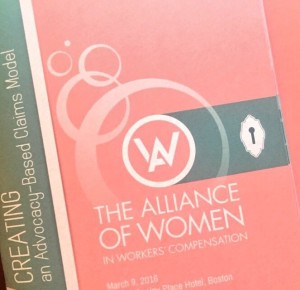Last Wednesday, over 170 women and – yes, men as well – gathered in Boston for The Alliance of Women in Workers’ Compensation workshop, and spent the day discussing “Creating an Advocacy-Based Claim Model.” While there will be a position paper coming out from the Alliance offering a more detailed look at this philosophy, I am offering a short report to give you an idea of the insights that came from our engaging discussion.

The panels featured some of the most iconic service companies in America representing close to one million employees around the world. The panelists energized the attendees with their groundbreaking ideas on how they are changing the way they and their partners are advocating for employees. Advocacy crosses risk management and benefit organizations and focuses on supporting those who are injured on the job or experience any number of unexpected challenges that interrupt their ability to provide for their families through a job they want to be doing. Every employer who spoke from the stage and collaborated in the workshop sessions believes as do I that almost everyone truly wants to work.
Employers understand that the employee experience – positive or negative – translates to customer service levels, consumer engagement and employee satisfaction. With an advocacy focus, we have a dynamic opportunity to improve on all of these fronts; we saw this resonating with the audience last week as they collaborated and discussed ways to bring advocacy initiatives into the workers’ compensation claims process. Some attendees focused on ways advocacy for their own workforce would improve talent attraction and retention in the insurance industry, while others addressed ways patient advocacy can improve outcomes for injured workers.
The workers’ compensation system was created to take care of those injured at work; an advocacy-based model aligns closely with the original intent of that system. Employers, payers, service providers, attorneys, regulator representatives, medical providers and consultants came together to discuss how we can use an advocacy approach to benefit the industry as a whole. Opportunities and challenges were openly debated.
We heard several panelists talk about starting by creating a culture of safety. One of our world-class employers discussed how to equip leaders to train their staff and set the right tone. What was so fantastic about this company – and trust me, almost everyone reading this has been touched by this organization – is what happens when one of their team is injured or a customer is injured. A supervisor or other team member goes to the hospital and meets the family members and, depending on the nature of what happened, material necessities and comforts are provided, such as clothes or a phone. Most important is the emotional support this gives; the employer shows that they care for that individual and the family. What a small gesture in some ways, but with such a huge, positive, long-standing impact.
There were important discussions about how our industry’s use of long-embedded terminology should change. When you begin a workers’ compensation claim discussion with words like “recorded statement,” “investigate,” “examine” or “assess your claim,” are we really off to a good start? We heard such a simple statement from a plaintiff's attorney when asked, “How do we put you out of business and avoid litigation?” His response: invest in Hallmark cards and send them to every injured person whose claim you are touching and wish them well, or simply ask, “How are you feeling today?” This is not sophisticated or difficult and, yet, time and again we heard those in attendance asking why do we make it so hard to care for an injured worker?
Panelists varied on how to achieve an advocacy-based model and whether it requires an organizational culture change; if it requires a single person or an entire team. And while we didn’t figure out all the answers, the Alliance advanced the dialogue and now it is time for our industry to begin the change. I think all who attended will agree it was an amazing day of discussion and learning. Of course, you don't turn around an industry that is 100 years old overnight. But it was exciting to hear from stakeholders across the industry who are all passionate about finding a way to change and evolve and, more importantly, they want to continue the conversation.
I can't wait to share our white paper that will dive deep into this topic. I think we can bring you some real-world solutions to see how advocacy can happen in your company or – if you are part of the industry – how we become advocates for the employees who come to us for support each day. For those who are interested in learning more about the March 9th Boston advocacy session and continuing the conversation, join the Out Front Ideas with Kimberly and Mark webinar tomorrow, March 15. Register at OutFrontIdeas.com. You can also view an archived version of the presentation after it has aired.
Share your thoughts with me on what it means to you to create an advocacy-based claim model in the comments section. Let’s keep the dialogue going.
Please follow me on Twitter @kimberlyanngeo and join myLinkedIn group, Transforming Healthcare for Tomorrow.
Kimberly George, SVP, Corporate Development, M&A, and Healthcare